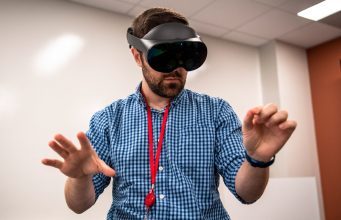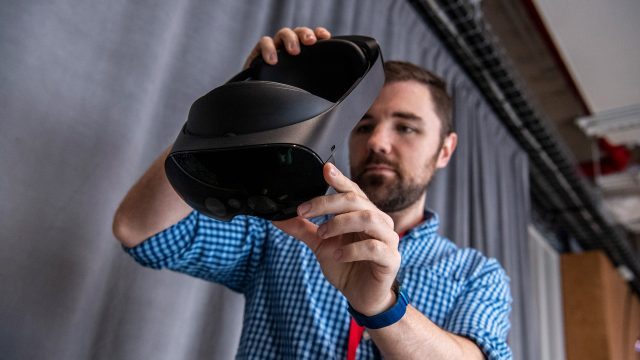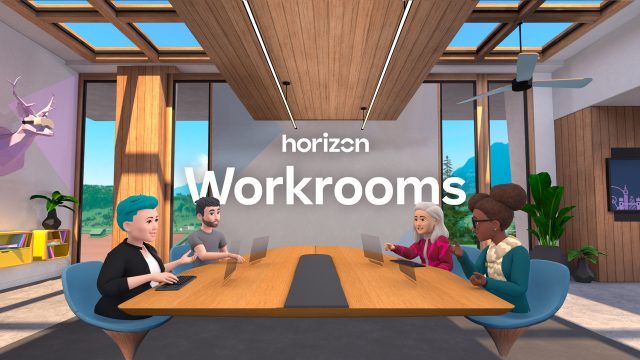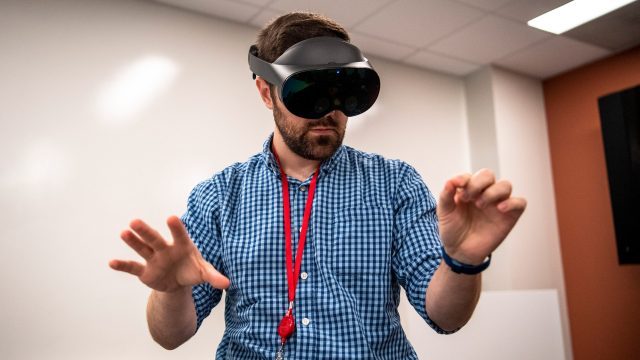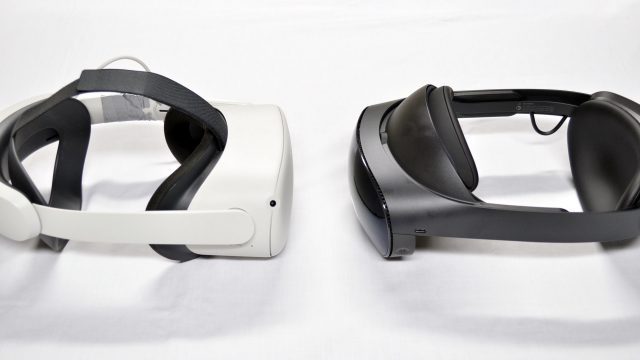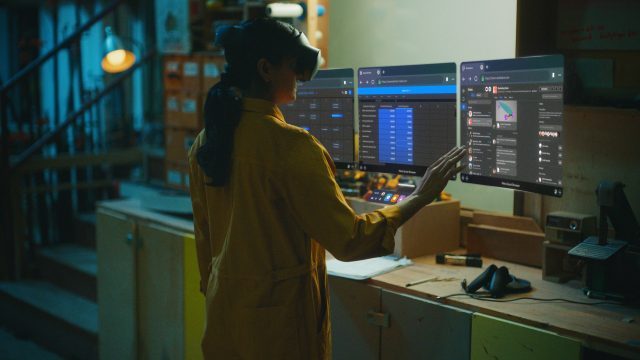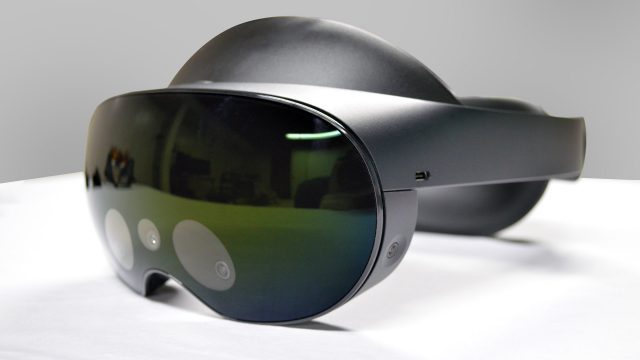https://ift.tt/JlIHpbW
We’ve been putting Quest Pro through its paces for the past few days – here’s what we think.
Quest Pro is not a variant of Quest 2, nor is it a successor. It’s the first in Meta’s new high-end product line targeting professionals, early adopters, developers, and businesses. Meta markets Quest Pro as a headset for both virtual and mixed reality.
The headset uses pancake lenses and the battery is built into the rear of the strap. That gives it a significantly slimmer visor than Quest 2. But it’s priced at a staggering $1500, almost four times Quest 2. Is it worth that much money? Who is it actually for? I’ll try to answer these questions below.
Click here for a full Quest Pro spec sheet & features rundown.
Light Blocking
Unlike pure VR headsets, Quest Pro doesn’t have a facial interface by default. You can still see the real world in your peripheral vision and below you.
Optional side light blockers included in the box magnetically attach to each side of the headset, but to block out the real world below your eyes you’ll need to buy Meta’s $50 Full Light Blocker. This accessory magnetically attaches too, as a single piece, but must be disconnected before using the headset’s included charging pad. The Full Light Blocker isn’t shipping until late November and I wasn’t able to acquire one in time for this review.

The Side Blockers make it very easy to see your keyboard & mouse in work-focused use cases, but nothing takes me out of immersive VR gaming more than seeing my bright carpet constantly below me. It even seems to make me feel slightly sick in games with artificial locomotion.
I’d argue this means Quest Pro is still weeks away from being able to act as a “full” VR headset.
Halo Strap & Comfort
Most VR headsets use a ski-goggle-style strap design, either elastic or rigid. This distributes the visor’s weight across your cheeks, forehead, and nose, secured against the back of your head with side straps and a top strap. This idea is used in mainline Quests, Pico headsets, Valve Index, HP Reverbs, Oculus Go, and the original Oculus Rift and HTC Vive. This approach crushes the sinuses under your lower forehead and cheeks. Pressure against the sinuses is very uncomfortable, so unless the visor is very light it’ll hurt in long sessions.
Quest Pro uses a different approach: the “halo strap” design. Halo straps put all the pressure against your upper forehead. The halo strap was first widely shipped in PlayStation VR and Sony still uses it for PSVR 2. The Oculus Rift S featured a halo and Microsoft chose this approach for HoloLens 2 as well. In fact, Quest Pro actually bears a striking resemblance to Microsoft’s latest AR headset.

The visor seems to float in front of you rather than truly being attached to your face. This keeps pressure off your sinuses but presents a dilemma. The wheel at the rear is the only strap adjustment and, unlike the ski-goggle approach, you can’t rotate the visor relative to the strap. If you loosen the wheel Quest Pro can be very comfortable. When you’re moving quickly, though, the visor will shift laterally. You can solve this by tightening it but then the pressure against your forehead is just as uncomfortable as a ski-goggle-style headset, if not more so. I experienced this same dilemma with PSVR and Rift S.
The loose fit is ideal for seated and less active use cases and I wrote most of this review comfortably inside Quest Pro with a Bluetooth keyboard. For active room-scale gaming I still prefer ski-goggle-style headsets.
IPD Adjustment
Each person has a slightly different distance between their eyes – their interpupillary distance (IPD). If a headset’s lenses aren’t closely aligned with your eyes the image can be blurry and it can even cause eye strain.
Quest 2 only offers three preset lens separation distances: 58mm, 63mm, and 68mm. Quest Pro’s lenses, however, feature continuous adjustment. Meta claims support for IPDs between 55mm and 75mm but the actual separation range is 58mm-72mm. Strangely, setting it to 72mm seems to be impossible as the lenses immediately slide back to 70mm. This happened on three Quest Pros tested by UploadVR.
During fast motions, the lenses can also sometimes slide away from their set position. They’re just too loose to stay in place – arguably a design flaw. For $1500, Quest Pro really should have self-moving motorized lenses like the Pico 4 Enterprise sold for half the price, as this would make IPD adjustment fully automatic.

That’s not to say IPD adjustment on Quest Pro is entirely manual. Eye tracking is off by default for privacy reasons, but if you enable it you can open a Fit Adjustment guide that measures your IPD and tells you to adjust the lenses to this value. This guide is buried in the settings and sometimes appears when launching an app, but I’m not sure exactly what prompts it. I tried purposely setting my IPD wrong while eye tracking was activated and the guide often doesn’t appear. I’d love an option to bring this up every time I put the headset on with the IPD set wrong, or every time I launch an app for demos to friends and family.
Lenses & Displays
If you’re coming from Quest 2, you’ll immediately notice Quest Pro’s wider field of view. It’s a welcome reversal after years of field of view stagnation in Oculus headsets.
Quest 2 has a horizontal field of view of 96°, but at the widest lens separation setting this drops to around 89° because the edge of the lens actually moves off the single panel. Quest Pro’s is 106°, and since it has dual panels the lens separation value doesn’t affect it. Field of view is arguably the single biggest driver of immersion in VR and switching back to Quest 2 feels somewhat claustrophobic.
The field of view isn’t the only optical improvement though. Quest Pro uses pancake lenses, sharper in the center and even out to the periphery compared to the fresnel lenses used in Quest 2. The difference here is dramatic. You can actually look toward the edge of the lenses and still clearly make things out without blur.
Pancake lenses also seem to steam up less than fresnel lenses, but this could just be related to the open periphery design of Quest Pro and the breathable fabric of Pico 4.

The other major improvement in the visuals of Quest Pro is the combination of Mini-LED local dimming and quantum dots. These displays can much more closely approximate black than the murky greys of Quest 2 and Pico 4, and the colors are more vibrant too. There’s the usual blooming inherent to LCD local dimming, but it’s no worse than the glare of fresnel lenses. Until OLED returns to standalone VR, this is the next best thing.
What hasn’t meaningfully improved is the actual resolution. The increase here is marginal, likely because Quest Pro is driven by the same GPU as Quest 2. You’ll see the same kind of aliasing and shimmering you may have seen in Quest 2, and it means the “replace your monitor” use case Meta is building toward isn’t truly practical yet. Quest Pro’s resolution is just not what many people would expect from a $1500 headset.
Mixed Reality
Quest Pro’s headline new feature is color passthrough for mixed reality. The headset was clearly designed around this feature, with its open periphery letting you see the real world instead of the black edges of VR-first headsets.
The passthrough is 3D and fully depth correct. It’s reconstructed from the stereo front-facing cameras leveraging the SLAM map generated by the headset tracking system and the central RGB camera adds color on top.
Moving objects like your hands and arms exhibit a double-imaging effect with the color lagging behind. Stationary objects appear rock solid though thanks to the essentially perfect headset tracking. You can lift up the visor and see objects at the exact same scale, size, and apparent distance you were seeing them in the headset. Even with far from photorealistic graphics, my brain accepts virtual objects as being truly there in my room. When I first tried this it was akin to using positionally tracked VR for the first time.
However, the actual image quality of the passthrough isn’t good at all. It’s grainy and washed out, like an old phone camera video recording. Yes, it’s better than Quest 2’s passthrough, but that’s really not saying a lot. I can just barely read the letters on my keyboard and I can’t read text on my phone at all, nor standard-sized font on a letter size page.
The graininess makes the passthrough less useful than a Vive Cosmos style flip-up visor, but it doesn’t really impact the usability of mixed reality apps since you’re interacting with virtual content. Your real room is essentially just the setting.

The real problem with mixed reality on Quest Pro is the need to set up your room. HoloLens 2, Magic Leap 2, iPhone Pro, and iPad Pro automatically scan your room and create a 3D mesh, which apps leverage for collision and occlusion between virtual and real objects. Room-aware mixed reality on Quest Pro, however, requires you to manually mark out your walls, ceiling, and furniture with the controllers. This arduous process adds significant friction to room-aware mixed reality and yields imperfect results. The only saving grace is Quest Pro remembers your playspace much more reliably than Quest 2, even after moving furniture around or in different lighting conditions.
Why is Quest Pro the odd one out? Because those other devices feature depth sensors. Quest Pro was meant to have one too, but it was dropped sometime in the past five months. Meta told me it’s looking into automatic plane detection – referring to flat surfaces like walls and tables. Frankly, Quest Pro feels unfinished without this. It’s astonishing for a $1500 device pitched for mixed reality shipping in 2022 to have no automatic awareness of its environment.
And bizarrely, despite Quest Pro’s mixed reality focus and its primitive implementation, this manual Room Setup is listed under “experimental” features.
One potential upside to Meta’s approach here is that if it can achieve room meshing with just 2D cameras, it should enable automatic room-aware mixed reality on even low-cost headsets like Quest 3. It reminds me of Tesla’s approach to self-driving. Competitors rely on expensive hardware-level depth sensing, but Tesla and Meta are betting on rapid advancements in machine learning rendering this a useless added cost in the future.
Performance & Tracking
Quest Pro is the first headset with Snapdragon XR2+ Gen 1. It’s essentially the same old chip from 2020 but with better thermal dissipation and support for more sensors and RAM.
The chip isn’t a new generation, so Quest Pro uses the same default render resolution as Quest 2 and the CPU/GPU levels chosen by developers correspond to the same clock frequencies. I didn’t see any performance difference.
The 12GB of RAM – double Quest 2’s 6GB – does enable a new feature though, letting you bring up the web browser without having to quit the running VR app. In theory it’s a useful addition, but in practice Quest Pro exhibits the same horrendous stuttering and unresponsiveness as Quest 2 when the system menu is brought up inside many VR apps. Installing or updating apps in the background also turns the home space and system menu into a laggy mess just like Quest 2.
These issues, though limited in scope, are a shame to see in a $1500 device. Meta and Qualcomm recently announced a partnership to develop next generation chips for future headsets. In the meantime, Quest Pro is stuck with a processor that’s just not powerful enough to match its ambitions.

Quest Pro does support eye-tracked foveated rendering – the technique where only the small region of the display you’re currently looking at is rendered in full resolution. As far as I’m aware Red Matter 2 is the only major game to currently support this. It was already considered the game with the highest graphical fidelity on Quest 2, but with foveated rendering the developer was able to increase the base resolution by 30%. Testing it out, I couldn’t notice any resolution shifting as I moved my eye, which means it’s working exactly as intended.
The most impressive core tech of Quest Pro though is the inside-out tracking – without a doubt the best I’ve ever used. It remains rock solid with no perceptible jitter, latency, or drift. Facebook has been working on this technology since acquiring 13th Lab in 2014, and it shows.
Pro Controllers & Hand Tracking
The star of the show is without a doubt the Touch Pro controllers. When the original Rift Touch controllers launched, UploadVR hailed them as ‘The World’s Best VR Controller’. Successive iterations of Touch took steps backward in some aspects, but I can confidently say Touch Pro re-takes the title.
Touch Pro is self-tracking, ditching the tracking rings for onboard cameras. Tracking works the same way as headset tracking, and it’s just as rock solid – not once have I seen tracking break. You can also bring them much closer together at any angle since you’re no longer at risk of bashing plastic you can’t see in VR. That may sound unimportant, but it actually opens up entirely new precise hand-to-hand interactions not possible on any other headset (Pico 4’s controller design is an improvement over Quest 2, but there are still angles they bash together).
The lack of a tracking ring also makes Touch Pro feel great in my hand. The new curved thumb rest feels more natural to grip and has a pressure sensor to enable grabbing, squeezing, and crushing small objects between your index finger and thumb. It doesn’t seem to have a capacitive sensor though. Unlike the buttons and thumbstick, you don’t see your thumb resting on it in VR.
The most impressive new feature is the new haptic system. There’s the primary motor in the handle but, for the first time in a consumer VR controller, there are secondary motors underneath the index trigger and thumb grip too. This lets developers target the haptics to the exact part of your hand touching the virtual object. Almost no apps take advantage of this yet, and it’s possible few ever will, but it’s a magical experience that blew me away when I first tried it.
The sensor in the trigger provides another new feature which can track the curling and sliding of your index finger. It’s more precise than the sensing on Valve Index controllers, but limited to your index finger only.
There is one downside to Touch Pro however. When you pick them up, syncing coordinate spaces between the headset and controllers takes a few seconds. Tracking works in this time, but it’s not in the correct position. This adds a new (albeit short) delay from putting on the headset to being able to properly use it and just feels downright janky compared to Quest 2. Meta needs to significantly speed this up with software updates. If that’s not possible, the company should track the controllers as objects using computer vision as a temporary placeholder until alignment, or it could have included a few infrared LEDs on the surface of the controller to help.

Quest Pro also supports controller-free hand tracking. The reliability and stability are noticeably improved from the mainline Quests, likely due to the higher resolution tracking cameras. Trying Meta’s First Hand demo on Quest Pro feels like a glimpse of the kind of future VR that will reach hundreds of millions of people, if not billions. As long as you’re in decent lighting conditions, this is the first time hand tracking feels truly ready for primetime in a shipping consumer product.
Hand tracking also now works when your hands are to your side, but there’s a dead zone between the front cameras and side cameras, so other people will see your avatar’s hands awkwardly snap when you bring them back in front of you.
Inexplicably though, hand tracking isn’t enabled by default. You’ll be prompted to set it up if you use one of the few apps that don’t support controllers, but otherwise it’s yet another critical feature hidden in Meta’s labyrinthian settings. Some buyers new to VR might not even know it exists.
An annoying issue I’ve experienced is the controllers suddently activating when docked, kicking me out of hand tracking mode. Meta tells me this is a bug and will be fixed with a software update soon.
Face Tracking
The other headline feature of Quest Pro is facial expression tracking: your gaze and facial expression are mapped to your avatar in real-time.
Not many apps actually support this yet, but you can try it out in the mirror of Horizon Worlds. It’s impressive technology, but I can’t help but feel the current Meta Avatars are just too graphically simplistic to really do it justice. Perhaps the graphics overhaul next year will be designed around face tracking.
There’s no tongue tracking at launch, which limits expressivity. Vive Focus 3 already supports this in its lower face tracking add-on and Meta indicated it is being explored for a future software update.
How impactful face tracking will be in the consumer space will depend on its adoption in popular social platforms like Rec Room, VRChat, and Bigscreen. As far as I can tell, there’s no way to pass face tracking data through to a PC right now, which will come as a disappointment to PC VRChat enthusiasts.
The Charging Dock
The biggest change to how Quest Pro actually fits into your life is the included charging dock. The idea is that you can jump into virtual or mixed reality as soon as you want. You no longer have to worry that your headset might not be charged and updated, or that your controllers might need new batteries.
The dock becomes an essential part of the hardware in the same sense charging cases did for wireless earpods. It feels like an idea that’s here to stay. Leaked schematics suggest Quest 3 will support a dock too, but given the price I’d imagine it’ll be a separate purchase rather than included in the box.

The Quest Pro headset slots easily onto the dock with no hassle even if you do need to remove the Full Light Blocker. Attaching the controllers though takes some getting used to since they slot in behind the visor at quite an awkward angle, sometimes requiring fiddling to actually connect them to the pins. Meta’s dock design is certainly space efficient, but it lacks the elegance and ease-of-use of side-by-side charging designs such as Anker’s dock for Quest 2.
Who Is Quest Pro For?
Quest Pro could be a no-brainer for profitable businesses already using Quest 2 with apps that could be enhanced by color mixed reality and avatars with facial expressions. That will be highly use-case dependent, though.
Quest Pro can also act as a development kit for cutting-edge developers looking to start building for mixed reality or social VR experiences.
But what about consumers? Unless $1500 somehow means very little to you or you’re adamant about being an early adopter of mixed reality, I can’t really recommend spending that much money on this headset. Quest Pro offers an early taste of technologies that will be foundational to the future of VR, but it’s held back by an aging processor generation that doesn’t enable higher-fidelity VR. Quest 3 is coming, and it may include a next-generation chip yet be sold at around a quarter of the price.
from UploadVR https://ift.tt/co6NlyO
via
IFTTT

